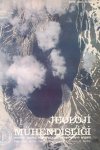
ABSTRACT : The power tunnel, which will convey the water from the Görmel dam to `the proposed hydroelectric power plant on the left slope of the Erik river,, was designed using data from, studies of the geotechnical properties of the rock units along the tunnel alignment. Data were evaluated using the Geomechanic RMR system and the Q system.. Support systems were recommended for the tunnel. The tunnel will be driven, through flysch faci.es of the Eocene Görmel. formation,, and through the matrix (sandstone, greywacke, spilite, diabase, gabbro., basalt) and limestone blocks of the Upper Cretaceous Çamlıca formasion. These limestone Mocks arc the members (Çetincekalesi, Tahtacı, Kükürce» Azıtepe limestone members) of the Çamlıca formation
ABSTRACT : Belence Black Marble deposits occur in Paleozoic metamorphic series. The metamorphic series consist of schist, quartzitc, calcschist, metasandstone, metaconglomerate, slate and recristalized limestone (black, marble),. Black marbles present in. two different .areas as Katırtaşı and Hacı Ilyas, Belence vicinity. The Black .marbles are thick-middle bedded and locally massive. Marbles are cut white calsite veins and. veinlets (0.3 mm- 3 cm thick). The black marbles are homogeneous in colour and texture laterally and vertically., Under microskopy, at thin sections of marbles, fine grained (10 - 75 micron) calsite .and microsparitic texture have been observed. The black marbles contain, calcite, quartz and opaque minerals.. Technological experiments showed that marbles can be cut as plate and marble tile (0-9 cm. thick.) and polished well. Phiysico-mechanicai tests have been, done on the Belence marble and their results, have been found as right TS 2513 and TS 1910. Reserve of Belence Black Marble deposite are, as indicated, reserve, total 209 375 000 m.3 (Katırtaşı; 75 000 000 m3 + Hacı Ilyas; 134 37.5 000)
ABSTRACT: Most of the mineralization zones are related to linear and curvilinear features. This is. due to the magma differentiation process where by the mineral rich fluids either solidify along existing lineaments (fractures) forming linear features, or intrude into the upper crust as igneous bodies forming; curvilinear features These linear1 features are conspicious and easily recognized on remotely .sensed data which invites the attention to the anomalous geologic features :fcr detailed investigation. Previous experiements to identify mineral target areas on LANDSAT imageries give encouraging results. Similarly; a Nigerian LANDSAT image interpretation indicates areas of high, potential for mineralization in South Gongola State,, Eastern Nigeria.
ABSTRACT : Route location is an important aspect of highway engineering., It proceeds a comprehensive transportation planning and. forms basis to highway design. Â route selection study is a multidisciplinary job. The common participated members are economist» archtiect,, city planner, environmentalist, sociologist, geomorphologist, and engineers. In engineering sense, geological study includes geological mapping, identification of major geological structures, lilhological propertics, hydrogcological characteristics» geomorphological features, natural slopes, distribution and types of mass movements,, distribution of aggregate sources (pit and quarries), and so forth, These items are effective on cost - benefit analysis and route evaluation as well as highway design characteristics. The main purpose here, is a scientific information spreading of general criteria of a route location study. Type, trend, and extent; of faults can control route, location. If the situation is properly understood, it may help to locate route in order to minimize related stability -problems along; an alignment. Folds, bedding attitudes» lithological contacts,, and intensity of joints and. fractures have effect on stability of motorway structures.. Engineering characteristics of the prevailing liihologies are quite important in the mute location study. Recognition of drainage pattern, seeps and. springs,, swamps, and marshy soft grounds, interrelationships between natural slopes and mass movements, surface and .groundwater conditions,, and their` basins future use (long term) plans have also significant role, in route location., Gravel - sand and crushed rock have place value rather than unit vale,. Therefore their analysis in. terms of quantity, quality, and areal distribution may also have influence, on route location, and as well as. highway design.
ABSTRACT : The engineering properties of a soil depends on the composite effects of several interacting and often interrelated factors as compositional and environmental., In this research.» mincralogical composition and geotecrmical properties of Upper Pliocene deposits» collected from. Sincan, Beşevler and Kavaklıdere sites (Ankara),, are studied and correlated. The samples» inorganic clay of high plasticity (CH),, and inorganic silt of high plasticity (MH) are used as the material. Deposits consist of quartz» calcite, albite and clay minerals.- Sincan deposits contain about 20 percent montmorillonit. Montmorilionit. causes decreasing in internal friction, and shear strength of the Sincan deposits and aparts from gcotechnical properties of Beşevler and Kavaklıdere deposits.
ABSTRACT: Carbonate platforms can be classified into four groups as; carbonate ramp» rimmed carbonate shelf» isolated-platforms and, drowned carbonate platforms. In this, paper, the terms of ramp, rimmed, shelf; isolated platform and drowned, platform .are used to describe gcomorphic, two-dimensional features. Carbonate, ramps may be homoclinal or distally steepened and may have fringing o:r barrier shoal-water complex, of ooid/pellet sands, or skeletal banks Homoclinal ramps pass seaward into deeper-water, without major1 break in slope, and they lack deep-water breccias. Distally steepened ramps may be low energy, .and are. characterized by widespread, .shallow» sub wave-base mud blankets, or high energy with coastal beach-dune, complexes and widespread skeletal sand blankets.Rimmed carbonate shelves have relatively flat,tops and marked break in. slopes at. shallow-shelf edge, where they pass into deep water.. They may be accretionary or depositional, and. bypass types include gullied, .slop, escarpment, and high- relief erosional forms Intraslielf basins, occur on. some shelves., controlling distribution, of reservoir and. source beds Isolated platforms are on rcfted continental margins» or on submarine volcanoes,. Platforms that have been, subjected to rapid .sea level rise may be incipiently drowned,, .and are characterized by raised rims, elevated patch on fine clastic blankets. The various types, of platforms change in ..response to vari.ati.ons. in sedimentation, subsidence or sea. level rise, and may form distinctive- evolutionary sequenc

 TMMOB
TMMOB